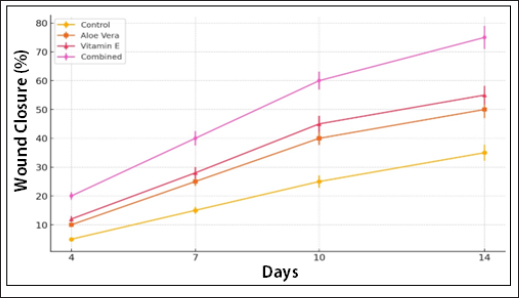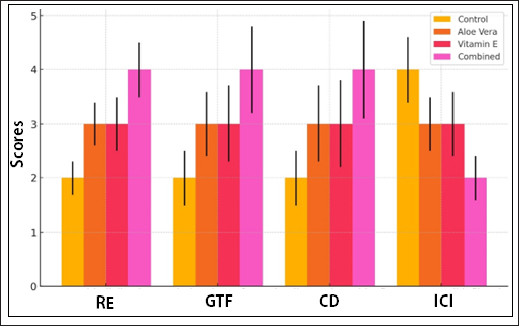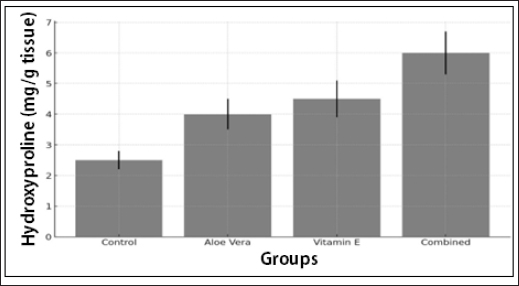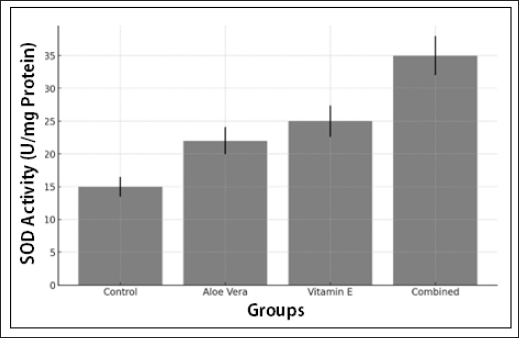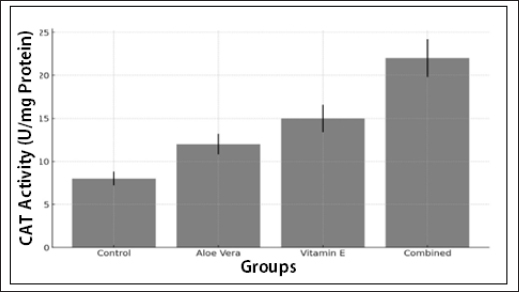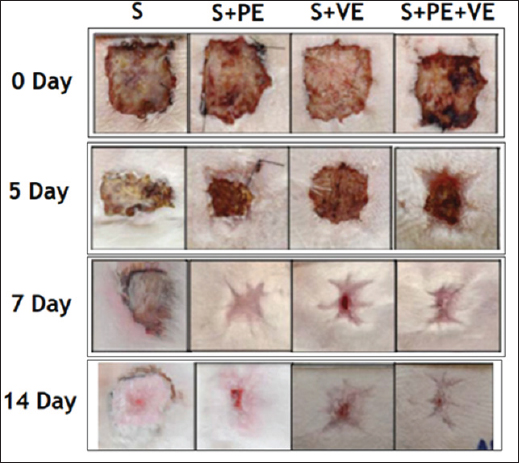
| Research Article | ||
Open Vet. J.. 2025; 15(2): 700-708 Open Veterinary Journal, (2025), Vol. 15(2): 700-708 Research Article Combined effects of Aloe vera leaf extract and vitamin E on wound healing in Oryctolagus cuniculus (Rabbits)Anila Khan1, Shakeeb Ullah2, Faiqah Ramzan2, Ata Ur Rehman2, Saifur Rehman2, Kholik Kholik3, Akhmad Sukri4, Muhammad Munawaroh5 and Teguh Hari Sucipto6*1Institute of Biological Sciences, Gomal University, Dera Ismail Khan, Pakistan 2Faculty of Veterinary and Animal Sciences, Gomal University, Dera Ismail Khan, Pakistan 3Department of Veterinary Public Health, Faculty of Veterinary Medicine, Universitas Pendidikan Mandalika, Mataram City, Indonesia 4Department of Biology Education, Faculty of Science and Engineering, Universitas Pendidikan Mandalika, Mataram City, Indonesia 5Department of Basic Medical Veterinary Medicine, Faculty of Veterinary Medicine, Universitas Pendidikan Mandalika, Mataram City, Indonesia 6Institute of Tropical Disease, Universitas Airlangga, Surabaya, Indonesia *Correspondence to: Teguh Hari Sucipto. Institute of Tropical Disease, Universitas Airlangga, Surabaya, Indonesia. teguhharisucipto [at] staf.unair.ac.id Submitted: 10/10/2024 Accepted: 07/01/2025 Published: 28/02/2025 © 2025 Open Veterinary Journal
AbstractBackground: Wound healing is a complex process involving inflammation, proliferation, and tissue remodeling. Aloe vera and vitamin E (Evion®) are well-known for their wound-healing properties because of their anti-inflammatory, antioxidant, and collagen-promoting effects. Aim: This study aimed to evaluate the comparative efficacy of A. vera leaf extract, vitamin E, and their combined application on wound healing in rabbits (Oryctolagus cuniculus). Methods: Twenty male rabbits were divided into four groups: control (treated with saline), A. Vera, vitamin E, and combined (A. Vera + vitamin E). Full-thickness wounds were created on the dorsum of each rabbit, and treatments were applied daily for 14 days. Wound closure rates were measured on days 0, 4, 7, 10, and 14, followed by histopathological and biochemical analyses. Results: By day 14, the combined treatment group demonstrated the most significant wound closure, reducing the wound area by 75% compared with 50% in the A. Vera group, 55% in the vitamin E group, and 35% in the control group. Histopathological analysis showed near-complete re-epithelialization, dense granulation tissue, and enhanced collagen deposition in the combined treatment group. The biochemical results indicated that the hydroxyproline levels were highest in the combined group (6.0 mg/g tissue) and that the antioxidant enzyme activity was elevated. Conclusion: These findings suggest a synergistic effect between A. Vera and vitamin E, leading to accelerated wound healing and improved tissue repair. The combination treatment has the potential to be a superior therapeutic approach for wound management. Keywords: Wound healing, Vitamin E, Collagen synthesis, Antioxidant enzymes, Aloe vera (Extract) IntroductionWound healing is a vital physiological process that restores tissue integrity after injury through a complex interplay of cellular, molecular, and biochemical pathways. The process progresses through four overlapping phases: hemostasis, inflammation, proliferation, and remodeling, each regulated by growth factors, cytokines, and enzymes. External factors such as nutrition, infection, and environmental conditions significantly influence this delicate process. Disruptions can lead to complications like chronic wounds, delayed healing, infections, and excessive scarring (Pereira et al., 2016; Zhao et al., 2016). In recent years, natural products have gained attention for promoting wound healing because of their biocompatibility, minimal side effects, and accessibility (Massoud et al., 2023). Among these, Aloe vera stands out for its well-documented wound-healing properties. Aloe vera is rich in bioactive compounds, such as polysaccharides, glycoproteins, vitamins, and amino acids, and enhances wound healing through anti-inflammatory, antimicrobial, and collagen- stimulating effects. It accelerates healing by reducing inflammation, promoting fibroblast proliferation, and enhancing collagen synthesis (Poordast et al., 2021). Similarly, vitamin E, particularly in the form of α-tocopherol, is known for its antioxidant and skin- protecting properties. Oxidative stress is a critical factor that impairs wound healing, and vitamin E mitigates this by neutralizing free radicals, reducing inflammation, and stabilizing cell membranes. Additionally, it stimulates collagen production, which is essential for tissue repair and wound closure (Moneib et al., 2015; Liang et al., 2021; Liu et al., 2021). The combination of A. vera and vitamin E holds particular promise because of their complementary mechanisms. Aloe vera primarily acts through anti- inflammatory and collagen-stimulating pathways, whereas vitamin E enhances tissue repair by mitigating oxidative stress and promoting membrane stability (Dattola et al., 2020). Despite extensive research on their individual benefits, few studies have explored the synergistic effects of combined A. vera and vitamin E for wound healing. This study aimed to evaluate the comparative efficacy of A. vera leaf extract, vitamin E, and their combination on wound healing in rabbits (Oryctolagus cuniculus). We hypothesize that the combined application of A. vera and vitamin E will result in superior wound- healing outcomes compared with individual treatments. These findings could pave the way for the development of more effective natural wound care therapies. Materials and MethodsExperimental designAloe vera leaf samples were collected from Habib Botanical Garden, Institute of Biological Sciences, Gomal University, D.I. Khan, Pakistan. The current study aimed to evaluate the efficacy of A. vera leaf extract, vitamin E, and their combined effect on wound healing in O. cuniculus (rabbits). A total of 20 healthy adult male rabbits, each weighing between 2.0 and 2.5 kg, were selected for the experiment. The rabbits were housed under standard laboratory conditions, including a 12-hour light/dark cycle, temperature of 22 ± 2°C, and 50%–60% humidity. They were fed a standard rabbit diet and provided water ad libitum. Aloe vera leaf extractFresh A. vera leaves were collected and thoroughly washed, and the outer green rind was carefully removed to extract the internal leaf tissues. The leaf tissue was then chopped into small pieces, homogenized, and filtered to obtain a clear extract. This extract was stored at 4°C and used within 24 hours to maintain the potency of the bioactive compounds. The final concentration of A. vera leaf extract was standardized at 10% w/v for the experiment. Vitamin E preparationVitamin E (α-tocopherol) was procured from an Evion®. A topical solution was prepared by dissolving vitamin E in a sterile carrier oil, such as olive oil, to achieve a concentration of 5% w/v. The solutions were stored in dark conditions at room temperature to prevent oxidation and were freshly prepared before each application. The concentrations of A. Vera (10%) and vitamin E (5%) used in this study were selected based on findings from previous research and their established efficacy in promoting wound healing. Aloe Vera at 10% concentration has been widely reported to exhibit optimal wound-healing properties by reducing inflammation, stimulating fibroblast activity, and enhancing collagen synthesis (Zhang et al., 2016; Islam et al., 2020). Similarly, a 5% concentration of vitamin E was chosen due to its proven antioxidant capacity and ability to promote tissue repair and regeneration without causing adverse effects (Moneib et al., 2015; Liang et al., 2021). Wound creationRabbits were anesthetized via intramuscular injection of xylazine (5 mg/kg) and ketamine (35 mg/kg). The dorsal area of each rabbit was shaved with 70% ethanol. A full-thickness skin wound, measuring 2 × 2 cm) was surgically created on the dorsum of each rabbit using a sterile scalpel. The wounds were standardized in size and depth to ensure consistency across all test subjects (Islam et al., 2020). Experimental groupsThe rabbits were randomly divided into four groups, with five rabbits in each group: Group I (Control): Treated with sterile saline solution. Group II (A. vera): Treatment with A. vera leaf extract. Group III (vitamin E): Treated with vitamin E solution. Group IV (Combined): Treatment with a combination of A. vera leaf extract and vitamin E solution. Each treatment was applied topically to the wounds once daily for 14 days. The quantity of A. vera extract, vitamin E solution, and their combination was standardized to cover the entire wound area. Wound healing and intestinal histopathological findingsThe following parameters were used to assess wound healing and intestinal histopathology: Wound closure rate The wound area was measured on days 0, 4, 7, 10, and 14 after wounding using digital calipers. Histopathological analysis On day 14, tissue samples were collected from both the wound sites and intestines for histopathological examination. The tissues were fixed in 10% formalin, embedded in paraffin, sectioned at 5 µm, and stained with Hematoxylin and Eosin (HandE) for microscopic evaluation. Key parameters assessed in the wound tissues included re-epithelialization, granulation tissue formation, collagen deposition, and inflammatory cell infiltration. In the intestinal tissues, the focus was on the assessment of mucosal integrity, inflammation, and overall histopathological changes in response to treatment. Biochemical analysis The collagen content in the wound tissues was assessed by measuring the hydroxyproline level using a standard colorimetric assay. Additionally, the activities of antioxidant enzymes such as superoxide dismutase (SOD) and catalase (CAT) were measured to evaluate the antioxidant capacity of treated wounds. SOD activitySOD activity was determined using the method described by Marklund and Marklund (1974). The assay was based on the ability of SOD to inhibit the autooxidation of pyrogallol in a Tris-EDTA buffer at pH 8.2. The rate of pyrogallol autooxidation was measured spectrophotometrically at 420 nm. One unit of SOD activity is defined as the amount of enzyme required to cause 50% inhibition of pyrogallol autooxidation under the assay conditions described by Marklund and Marklund (1974). Catalase activityCAT activity was measured using the method of Aebi (1984). The decomposition of hydrogen peroxide (H2O2) by catalase was monitored at 240 nm. The assay mixture contained 50 mM phosphate buffer (pH 7.0) and 10 mM H2O2. One unit of CAT activity is the amount of enzyme required to decompose 1 μmol of H2O2 per minute at 25°C (Aebi, 1984). Statistical analysisData were analyzed using SPSS software (version 25.0), and results are expressed as mean ± SD. Differences between groups were determined using one-way analysis of variance, followed by Tukey’s post hoc test for multiple comparisons. A p-value of 0.05 was considered statistically significant. Ethical approvalThe present investigation was approved by the ethical review committee of the Faculty of Veterinary and Animal Sciences at Gomal University (approval number 1940/FVAS/GU). ResultsWound healing assessmentWound closure rate The wound closure rate was monitored over a period of 14 days, and significant differences were observed between the groups. The combined group (A. Vera + vitamin E) demonstrated the fastest and most efficient wound healing, followed by the A. Vera and vitamin E groups individually, whereas the control group had the slowest rate of wound closure. Control group The control group, which was treated with saline, exhibited minimal wound healing. By day 14, the wound area had reduced by only 35%, with incomplete wound closure and significant inflammation still present. Aloe vera groupThe A. Vera group showed a more rapid wound contraction compared with the control group. By day 14, wound closure had reached approximately 50%, with notable improvement in granulation tissue formation and epithelialization. Aloe vera’s antiinflammatory and collagen-promoting properties contributed to the accelerated healing. Vitamin E group The vitamin E group exhibited a slightly better wound closure rate than the A. Vera group, with a 55% reduction in wound size by day 14. Vitamin E’s role in protecting the wound from oxidative stress and promoting cell membrane stability likely enhances the wound closure process. Combined (A. Vera + vitamin E) group The combined group showed the most significant wound closure, with a 75% reduction in the wound area by day 14. The combined effects of Alovera’s antiinflammatory properties and vitamin E antioxidantt activity resulted in faster reepithelialization and greater tissue regeneration. The percentage of wound contraction measured on days 4, 7, 10, and 14 for each treatment group, including the control, A. vera, vitamin E, and combined groups. Wound closure percentage over a 14-day period in the control, A. vera, vitamin E, and Combined treatment groups. The combined treatment group exhibited the fastest and most significant wound closure Figure 1.
Fig. 1. The graph illustrates the wound closure rate (%) over time (days) for four different treatment groups: control, A. vera, vitamin E, and combined treatment (A. vera + vitamin E). Measurements were taken at four key time points: Days 4, 7, 10, and 14 for Control Group Aloe vera Group; Vitamin E Group and Combined Treatment Group. Histopathological findingsHistopathological analysis was conducted on day 14 to evaluate the quality of wound healing at the microscopic level. Key parameters assessed included re-epithelialization, granulation tissue formation, collagen deposition, and inflammatory cell infiltration. Control group The control group exhibited incomplete re- epithelialization, moderate granulation tissue formation, and sparse collagen deposition. A significant number of inflammatory cells were present, indicating ongoing inflammation and delayed wound healing. Aloe vera groupThe A. vera group showed improved reepithelialization and more organized granulation tissue compared with the control group. Collagen fibers were moderately organized, and inflammatory cell infiltration was reduced, indicating better healing. Vitamin E group The vitamin E group exhibited similar improvements as the A. vera group, with enhanced collagen deposition and better-organized granulation tissue. Inflammatory cell infiltration was lower than that of the control, reflecting more advanced healing. Combined group The combined group had the most advanced wound healing. Nearly complete re-epithelialization, dense granulation tissue formation, and high collagen deposition were observed. The inflammatory cell infiltration was minimal, indicating that the healing was well-resolved. The histopathological features of wound tissues, including re-epithelialization, granulation tissue formation, collagen deposition, and inflammatory cell infiltration, observed in the Control, A. Vera, vitamin E, and Combined treatment groups. Histopathological scores for re-epithelialization, granulation tissue formation, collagen deposition, and inflammatory cell infiltration on day 14 in the different treatment groups. The combined treatment group exhibited the most advanced healing Figure 2.
Fig. 2. Mean (±SD) histopathological scores for key wound healing parameters, including Re- Epithelialization (RE), Granulation Tissue Formation (GTF), Collagen Deposition (CD), and Inflammatory Cell Infiltration (ICI), in rabbit wounds treated with A. vera, vitamin E, their combination, and control. Each color represents a different treatment group: Control (yellow), A. Vera (orange), vitamin E (red), and Combined (magenta). The heightened scores in the A. vera, vitamin E, and combined groups compared with the control group suggest enhanced wound repair and tissue regeneration. Biochemical analysisBiochemical markers of wound healing were measured, including hydroxyproline levels (indicative of collagen content), SOD activity, and CAT activity. These markers provided insight into the antioxidant capacity and tissue regeneration of the groups. Hydroxyproline levels The hydroxyproline content was highest in the combined treatment group (6.0 mg/g tissue), indicating enhanced collagen synthesis. The A. vera and vitamin E groups showed moderate increases in hydroxyproline content compared with the control group Figure 3.
Fig. 3. The figure depicts hydroxyproline levels (µg/mg of tissue) across the four treatment groups—Control, A. Vera, vitamin E, and Combined (A. Vera + vitamin E)—measured at the endpoint of the study to evaluate collagen content and wound healing efficacy. SOD activity The combined treatment group exhibited the highest SOD activity (35 U/mg protein), indicating better antioxidant protection. The A. vera and vitamin E groups also had elevated SOD levels compared with the control group. CAT activity Similar to that of SOD, CAT activity was highest in the combined group (22 U/mg protein). The A. Vera and vitamin E groups exhibited moderate increases in CAT activity, whereas the control group had the lowest levels. The levels of hydroxyproline, SOD, and CAT activity in the wound tissues of the control, A. Vera, vitamin E, and Combined treatment groups. The combined application of A. Vera and vitamin E significantly outperformed individual treatments and the control group in all aspects of wound healing. This group had the fastest wound closure, the most advanced histological features, and the highest biochemical marker levels Figure 6. The A. Vera and vitamin E groups individually also showed improved healing compared with the control group, but the combined treatment exhibited a synergistic effect, resulting in enhanced tissue repair, higher collagen synthesis, and better antioxidant defense. SOD activity levels in wound tissues from each treatment group, with the combined treatment showing the highest antioxidant enzyme activity Figure 4.
Fig. 4. The figure illustrates SOD activity (units/mg of protein) in the four treatment groups— Control, A. Vera, vitamin E, and Combined (A. Vera + vitamin E). SOD activity serves as a critical marker of the antioxidant defense mechanism during wound healing, indicating its ability to neutralize superoxide radicals and reduce oxidative stress. CAT activity levels in wound tissues from the treatment groups demonstrate the enhanced antioxidant protection provided by the combined treatment Figure 5.
Fig. 5. The figure illustrates CAT activity (units/mg of protein) across the four treatment groups—Control, A. Vera, vitamin E, and Combined (A. Vera + vitamin E). CAT activity reflects the enzymatic antioxidant defense system’s ability to decompose hydrogen peroxide (H2O2) into water and oxygen, thereby reducing oxidative stress and preventing cellular damage during wound healing. DiscussionThe results of this study provide compelling evidence for the enhanced wound-healing effects of the combined application of A. vera leaf extract and vitamin E compared with their individual use and a saline-treated control. This discussion will elaborate on the underlying mechanisms and implications of these findings across various parameters: wound closure rate, histopathological features, and biochemical markers. The wound closure rate is a key indicator of the effectiveness of any wound treatment. In this study, the combined A. Vera + vitamin E treatment group exhibited the fastest and most substantial wound closure, with a 75% reduction in the wound area by day 14, compared with 50% and 55% reductions in the . Vera and vitamin E groups, respectively. The control group, which was treated with saline, showed only a 35% reduction, reflecting the natural but slow progression of untreated wound healing. The superior performance of the combined treatment can be attributed to the complementary mechanisms of A. Vera and vitamin East A. Vera has well-documented anti-inflammatory properties, promoting faster wound contraction by reducing inflammation and stimulating fibroblast activity. Vitamin E, on the other hand, is a potent antioxidant that mitigates oxidative stress, which can otherwise delay wound healing by damaging cellular components such as lipids, proteins, and DNA (Liu et al., 2021). Aloe vera reduces inflammation and creates an optimal environment for repair, whereas vitamin E protects the wound from oxidative damage, allowing for more rapid and efficient tissue regeneration. Additionally, collagen synthesis—a crucial component of wound healing—was enhanced in the combined group. Both A. Vera and vitamin E stimulate collagen production, but when used together, they likely act synergistically to increase the deposition and organization of collagen fibers, promoting faster and more robust tissue repair (Liang et al., 2021; Altay et al., 2023).
Fig. 6. The figure displays a photographic record of wound healing progression in individual rabbits from each of the four treatment groups—Control, A. Vera, vitamin E, and Combined (A. Vera + vitamin E). The images were captured at four key time points: Day 0 (baseline), Day 4, Day 7, and Day 14, documenting the morphological changes in wound size and appearance over time. Histopathological findings on day 14 further supported the superior wound healing observed in the combined treatment group. This group exhibited nearly complete re-epithelialization, dense granulation tissue formation, and the highest levels of collagen deposition. These findings indicate that combined treatment facilitated advanced wound healing by enhancing both the proliferation and remodeling phases. The process of reepithelialization involves the migration and proliferation of keratinocytes to cover the wound surface, which is essential for restoring skin barrier function. The nearly complete reepithelialization observed in the combined group suggests that wound healing was significantly accelerated compared with the other groups. Aloe vera’s ability to stimulate the migration and proliferation of epithelial cells, combined with vitamin E’s membrane-stabilizing effects, likely contributed to this enhanced result (Zhao et al., 2016). Granulation tissue consists of new capillaries, fibroblasts, and extracellular matrix components like collagen, and its formation is critical for wound repair. The dense granulation tissue observed in the combined group reflects more advanced wound healing, as both A. vera and vitamin E stimulate fibroblast proliferation and collagen synthesis. Aloe vera contains polysaccharides like acemannan, which have been shown to stimulate fibroblast activity and increase granulation tissue formation, while vitamin E aids in protecting these newly formed cells from oxidative stress (Moreira et al., 2024). Collagen is a primary structural component of the extracellular matrix in the skin, and its synthesis is critical for tissue strength and integrity. The higher levels of collagen deposition in the combined group (as indicated by both histopathological analysis and hydroxyproline measurements) suggest that A. Vera and vitamin E work together to enhance the synthesis and organization of collagen fibers, leading to stronger and more resilient healed tissue (Altay et al., 2023). Biochemical analysis was used to further elucidate the mechanisms underlying the improved wound healing in the combined treatment group. The hydroxyproline levels (a marker of collagen content) were significantly higher in the combined group (6.0 mg/g tissue), indicating enhanced collagen synthesis. This supports the hypothesis that the combination of A. Vera and vitamin E acts synergistically to promote collagen production, which is crucial for wound contraction and strength. Antioxidant enzyme activities (SOD and CAT) were also markedly higher in the combined group compared with the other groups. This suggests that the combination of A. Vera and vitamin E provides superior protection against oxidative stress, a key factor that can impair wound healing by causing cellular damage (Liu et al., 2021). SOD and CAT are important enzymes that mitigate oxidative stress by neutralizing reactive oxygen species. Elevated SOD and CAT activities in the combined treatment group indicate a stronger antioxidant defense, allowing for better preservation of cellular function and tissue integrity during the wound healing process. Vitamin E’s role as a lipid- soluble antioxidant is well established, and its ability to protect cell membranes from oxidative damage is likely enhanced by the anti-inflammatory properties of A. Vera, which reduces the oxidative burden in the wound area (Liang et al., 2021). Sofini et al. (2024) reported that nanohydrogels infused with selected plant extracts effectively promote scarless wound healing by enhancing collagen synthesis and reducing inflammation. The combined treatment’s superior performance across all parameters—wound closure rate, histopathological features, and biochemical markers—strongly suggests a synergistic effect between A. Vera and vitamin East Although both agents independently improved wound healing, their combination enhanced healing to a greater extent than either agent alone. Sharon et al. (2024) comprehensively reviewed nanostructure-assisted wound dressing materials, highlighting their superior biocompatibility and effectiveness in accelerating wound healing. This synergy likely arises from A. vera’s role in modulating inflammation and stimulating fibroblast activity, combined with vitamin E’s antioxidant properties and collagen-enhancing effects. Aloe vera’s ability to reduce proinflammatory cytokines (e.g., interleukin-1 and tumor necrosis factor-alpha) and its antimicrobial properties create a favorable environment for healing, while vitamin E prevents oxidative damage and supports cellular repair (Barbosa et al., 2021). Mercy et al. (2024) demonstrated that nanohydrogel formulations combining plant extracts and nanosilver significantly enhance wound healing by reducing oxidative stress and promoting tissue regeneration. Together, these actions create an optimal environment for wound healing, allowing for faster re-epithelialization, enhanced granulation tissue formation, and more efficient collagen synthesis (Jessy et al., 2024). These findings have important clinical implications for wound management. The combination of A. Vera and vitamin E could be used as a topical treatment to enhance wound healing in both human and veterinary medicine. This treatment may be particularly beneficial for patients with chronic wounds or those with impaired healing capacity, such as those with diabetes or compromised immune systems. The natural origin and minimal adverse effects of A. vera and vitamin E make these agents attractive alternatives to synthetic wound-healing agents. ConclusionIn conclusion, the findings of this study demonstrate that the combined application of A. Vera and vitamin E significantly enhances wound healing compared with individual treatments or the control. This improvement was evidenced by faster wound closure, advanced histopathological features, and enhanced biochemical markers. The synergy between A. vera’s anti-inflammatory and fibroblast-stimulating properties and vitamin E’s antioxidant and collagen-enhancing effects creates an ideal environment for tissue repair, resulting in more effective and efficient healing. These results highlight the potential of A. Vera and vitamin E as a promising combination therapy for wound management. Further research is required to investigate the molecular mechanisms underlying this synergy and assess its efficacy across various wound models. Study limitationsThe limitations of the study are discussed, providing a basis for future research directions. AcknowledgmentsAll the authors acknowledge this work to Gomal University Dera Ismail Khan, Universitas Airlangga, and Universitas Pendidikan Mandalika, Indonesia. FundingAPC was funded by Universitas Airlangga Surabaya Indonesia. Authors ContributionsAll authors conceptualized and executed the processes, composed and amended the manuscript, and endorsed the final edition. ReferencesAebi, H. 1984. Catalase in vitro. Methods Enzymol. 105, 121–126. Altay Benetti, A., Tarbox, T., and Benetti, C. 2023. Current insights into the formulation and delivery of therapeutic and cosmeceutical agents for aging skin. Cosmetics, 10(2), 54. Barbosa, R., Villarreal, A., Rodriguez, C., De Leon, H., Gilkerson, R., and Lozano, K. 2021. Aloe vera extract-based composite nanofibers for wound dressing applications. Mater. Sci. Eng. C. Mater. Biol. Appl, 124, 112061. Dattola, A., Silvestri, M., Bennardo, L., Passante, M., Scali, E., Patruno, C., and Nisticò, S. P. 2020. Role of vitamins in skin health: a systematic review. Curr. Nutr. Rep, 9, 226–235. Islam, M. South; Ali, M. M. and Dadok, F. 2020. Effect of supplemental Aloe vera gel and amla fruit extract in drinking water on growth performance, immune response, hematological profiles, and gut microbial load of broiler chicken. J. Biosci. Agric. Res. 24, 2030–2038. Liang, J., Cui, L., Li, J., Guan, S., Zhang, K. and Li, J. 2021. Aloe vera: a medicinal plant used in skin wound healing. Tissue. Eng. Part. B. Rev, 27(5), 455–474. Liu, X., Yang, G., Luo, M., Lan, Q., Shi, X., Deng, H. and Zhang, C. 2021. Serum vitamin E levels and chronic inflammatory skin diseases: a systematic review and meta-analysis. PLoS One 16(12), e0261259. Jessy Mercy, D., Thirumalai, A., Udayakumar, S., Deepika, B., Janani, G., Girigoswami, A., and Girigoswami, K. 2024. Enhancing wound healing with nanohydrogel-entrapped plant extracts and nanosilver: an in vitro investigation. Molecules 29(21), 5004. Marklund, S. and Marklund, G. 1974. Involvement of the superoxide anion radical in the autooxidation of pyrogallol and a convenient assay for superoxide dismutase. Eur. J. Biochem. 47(3), 469–474. Massoud, D., Alrashdi, B.M., Fouda, M., El-Kott, A., Soliman, S.A. and Abd-Elhafeez, H.H. 2023. Aloe vera and wound healing: a brief review. Braz. J. Pharm. Sci, 58, e20837. Mercy, D.J., Thirumalai, A., Udayakumar, S., Deepika, B., Janani, G., Girigoswami, A. and Girigoswami, K. 2024. Enhancing wound healing with nanohydrogel-entrapped plant extracts and nanosilver: an in vitro investigation. Molecules 29(21), 5004. Moreira, T.D., Martins, V.B., da Silva Júnior, A.H., Sayer, C., de Araújo, P.H.H. Immich, A.P.S. 2024. New insights into biomaterials for wound dressings and care: challenges and trends. Prog. Org. Coat. 187, 108118. Moneib, North A. and Hussein, M.A. 2015. The potential of vitamin E as a wound-healing agent: recent insights. J. Adv. Res. 6(2), 109–121. Pereira, R.F. and Bartolo, P.J. 2016. Traditional therapies for skin wound healing. Adv. Wound. Care, 5(5), 208–229. Poordast, T., Ghaedian, L., Ghaedian, L., Najib, F. South, Alipour, S., Hosseinzadeh M. and Hosseinimehr, South J. 2021. Aloe vera; a new treatment for atrophic vaginitis, a randomized double-blinded controlled trial. J. Ethnopharmacol. 270, 113760. Sharon Sofini, P.S., Biswas, K., Mercy, D.J., Girigoswami, A. and Girigoswami, K. 2024. Nanostructure-assisted wound dressing materials: a literature review. Macromol. Res., 32(11), pp.1065–1087. Sofini, P.S., Mercy, D.J., Raghavan, V., Isaac, J.B., Deepika, B., Udayakumar, S., Janani, G., Devi, S., Kiran, V., Harini, A. and Girigoswami, A. 2024. Evaluation of scarless wound healing after nanohydrogel infused with selected plant extracts. J. Drug. Deliv. Sci. Technol. 100, 106118. Zhang, X. and Yu, L. 2016. The role of Aloe vera and its active compounds in promoting wound healing. Chin. J. Integr. Med. 22(5), 376–382. Zhao, R., Liang, H., Clarke, E., Jackson, C. and Xue, M. 2016. Inflammation in chronic wounds. Int. J. Mol. Sci. 17(12), 2085. | ||
| How to Cite this Article |
| Pubmed Style Khan A, Ullah S, Ramzan F, Rehman AU, Rehman S, Kholik K, Sukri A, Munawaroh M, Sucipto TH. Combined effects of Aloe vera leaf extract and vitamin E on wound healing in Oryctolagus cuniculus (Rabbits). Open Vet. J.. 2025; 15(2): 700-708. doi:10.5455/OVJ.2025.v15.i2.18 Web Style Khan A, Ullah S, Ramzan F, Rehman AU, Rehman S, Kholik K, Sukri A, Munawaroh M, Sucipto TH. Combined effects of Aloe vera leaf extract and vitamin E on wound healing in Oryctolagus cuniculus (Rabbits). https://www.openveterinaryjournal.com/?mno=224114 [Access: December 02, 2025]. doi:10.5455/OVJ.2025.v15.i2.18 AMA (American Medical Association) Style Khan A, Ullah S, Ramzan F, Rehman AU, Rehman S, Kholik K, Sukri A, Munawaroh M, Sucipto TH. Combined effects of Aloe vera leaf extract and vitamin E on wound healing in Oryctolagus cuniculus (Rabbits). Open Vet. J.. 2025; 15(2): 700-708. doi:10.5455/OVJ.2025.v15.i2.18 Vancouver/ICMJE Style Khan A, Ullah S, Ramzan F, Rehman AU, Rehman S, Kholik K, Sukri A, Munawaroh M, Sucipto TH. Combined effects of Aloe vera leaf extract and vitamin E on wound healing in Oryctolagus cuniculus (Rabbits). Open Vet. J.. (2025), [cited December 02, 2025]; 15(2): 700-708. doi:10.5455/OVJ.2025.v15.i2.18 Harvard Style Khan, A., Ullah, . S., Ramzan, . F., Rehman, . A. U., Rehman, . S., Kholik, . K., Sukri, . A., Munawaroh, . M. & Sucipto, . T. H. (2025) Combined effects of Aloe vera leaf extract and vitamin E on wound healing in Oryctolagus cuniculus (Rabbits). Open Vet. J., 15 (2), 700-708. doi:10.5455/OVJ.2025.v15.i2.18 Turabian Style Khan, Anila, Shakeeb Ullah, Faiqah Ramzan, Ata Ur Rehman, Saifur Rehman, Kholik Kholik, Akhmad Sukri, Muhammad Munawaroh, and Teguh Hari Sucipto. 2025. Combined effects of Aloe vera leaf extract and vitamin E on wound healing in Oryctolagus cuniculus (Rabbits). Open Veterinary Journal, 15 (2), 700-708. doi:10.5455/OVJ.2025.v15.i2.18 Chicago Style Khan, Anila, Shakeeb Ullah, Faiqah Ramzan, Ata Ur Rehman, Saifur Rehman, Kholik Kholik, Akhmad Sukri, Muhammad Munawaroh, and Teguh Hari Sucipto. "Combined effects of Aloe vera leaf extract and vitamin E on wound healing in Oryctolagus cuniculus (Rabbits)." Open Veterinary Journal 15 (2025), 700-708. doi:10.5455/OVJ.2025.v15.i2.18 MLA (The Modern Language Association) Style Khan, Anila, Shakeeb Ullah, Faiqah Ramzan, Ata Ur Rehman, Saifur Rehman, Kholik Kholik, Akhmad Sukri, Muhammad Munawaroh, and Teguh Hari Sucipto. "Combined effects of Aloe vera leaf extract and vitamin E on wound healing in Oryctolagus cuniculus (Rabbits)." Open Veterinary Journal 15.2 (2025), 700-708. Print. doi:10.5455/OVJ.2025.v15.i2.18 APA (American Psychological Association) Style Khan, A., Ullah, . S., Ramzan, . F., Rehman, . A. U., Rehman, . S., Kholik, . K., Sukri, . A., Munawaroh, . M. & Sucipto, . T. H. (2025) Combined effects of Aloe vera leaf extract and vitamin E on wound healing in Oryctolagus cuniculus (Rabbits). Open Veterinary Journal, 15 (2), 700-708. doi:10.5455/OVJ.2025.v15.i2.18 |





